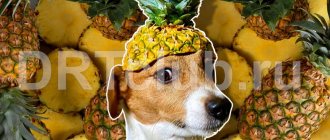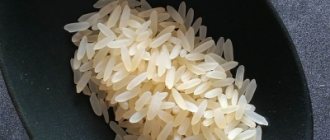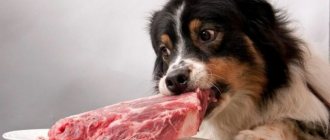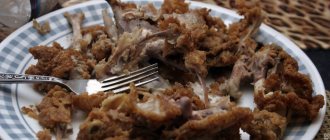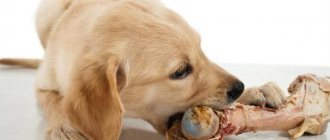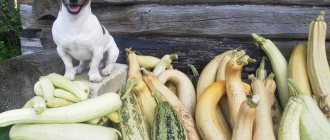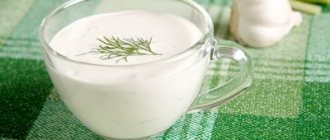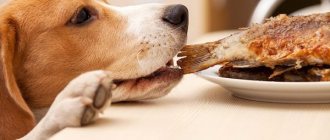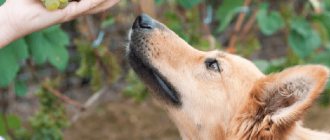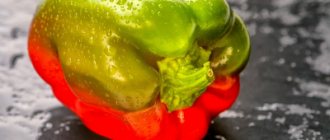The purpose of this article is to warn inexperienced owners against mistakes when choosing treats for their beloved four-legged friend and to dispel the persistent misconception that gnawing bones is natural and healthy. To avoid irreparable disaster, you need to clearly know what bones can be given to dogs. We will also give important recommendations.
Why does a dog like to chew a bone?
Chewing bones is a natural process for dogs that is enjoyed by different breeds. This allows them to scratch their gums and remove plaque. This behavioral habit has evolved over many centuries, and the best proof of this is the powerful jaws of pets.
Solid remains of the carcass act as natural exercise equipment and often replace toys. Even a well-fed and satisfied individual will happily gnaw on a fragrant delicacy.
Arguments for
- Gnawing on the right bones is good for the dental system. Pets that are limited in solid food do not have the necessary exercise. This leads to gum disease and loosening of teeth, because there is no training and massage of the gums. In addition, soft plaque is naturally removed and tartar does not form.
- Bones, although not a replacement for good nutrition, are an additional source of minerals: calcium, phosphorus, boron. If a dog chews cartilage, it is also good for joints, it contains glucosamine and chondroitin.
- In addition, bones are a natural “distraction” for the dog and anti-stress. After all, pets can usually chew a tasty bone with gusto, so much so that they cannot be seen or heard.
Useful and dangerous qualities of bones for dogs
Quadrupeds love to chew sticks, tree branches, and bone remains because their teeth were genetically adapted to eating the tough waste of wild animals.
Benefit
Most owners do not see anything wrong with the desire of four-legged animals to gnaw bones. Indeed, this product helps keep your dog's teeth clean. Thus, chewing large bones for dogs is an opportunity to remove stuck pieces of food. In addition, cartilage removes plaque in which bacteria accumulate and multiply.
Solid waste from meat production is good for your gums. They massage their surface, helping to prevent the development of periodontal disease, stomatitis and gingivitis. This occurs due to the removal of dead epithelial particles.
We must not forget that dog bones are also used as toys. These are natural objects that help shift attention from the owner’s furniture and shoes to more harmless activities. Zoologists and veterinarians have noticed that when dealing with hard meat, the dog calms down.
In addition, by eating cartilage, the four-legged friend receives the vitamins and substances necessary for proper development: calcium, phosphorus, amino acids.
Harm and dangerous consequences
All owners of champions, regular participants in exhibitions and competitions know that natural oils are absolutely unacceptable for their pets. They cause teeth to wear down, damage the outer enamel and cause changes in the bite.
The same problems arise in all pets who spend too much time chewing on something hard. In addition to dental problems, soft tissue difficulties may arise. Shards and sharp parts damage the dog's gums and palate. In the future, scratches and injuries provoke the development of inflammation in the oral cavity.
Sometimes debris gets stuck in the larynx or esophagus of your four-legged friend. Because of this, there is a need to visit a veterinarian to help get rid of the problem.
Frequent consumption of moslov causes dangerous inflammatory processes in the abdominal cavity. This occurs due to constant mechanical injuries - bone fragments can injure the organs of the digestive tract.
Briefly about the main thing
- Chicken bones injure the internal organs of dogs, which can cause the death of a pet;
- There are no nutrients in the bones; they will not satisfy your hunger;
- An adult dog should not constantly chew on something;
- A dog can brush its teeth with treats or toys from a pet store;
- Beef and pork bones are included in the permitted list;
- Allowed foods can only be given raw;
- Turkey, rabbit and fish are just as harmful as chicken;
- First aid is the “candle method”: wax “neutralizes” sharp corners;
- If you see blood in your vomit or feces, call your veterinarian.
Which types are possible and which are not?
Traditionally, domestic animals are fed meat and by-products from cows, goats, sheep, horses or birds. Experienced owners know for sure whether they can give beef or other bones to their dogs, but their opinions often differ. The main requirement for choosing solid products is their spongy structure, the presence of meat residues and tendons on them. The size of the bridges is also important.
Pork
Pork is considered not a very healthy product for dogs. Almost all parts of the pork carcass contain a lot of fat, so excessive consumption leads to obesity and problems with the cardiovascular system. Solid carcass residue is also undesirable for your pet. They cause the dog to become infected with helminths.
Beef or lamb
When choosing beef or lamb, you should give preference to young animals. Their meat and offal contain many useful vitamins and microelements.
The same applies to parts of the skeleton. Only spongy muscles (ribs, collarbones, joint parts, vertebrae) that can be chopped will be useful for feeding your pet. Then the dog will easily get to the tasty core and will not hurt his mouth or stomach.
Chicken
Chicken is a cheap type of meat, therefore it is popular in the nutrition of four-legged animals. In addition, this is a dietary product. Inexperienced dog breeders are wondering whether it is possible to give their dog chicken bones.
Veterinarians give a clearly negative answer. When chewed, they crumble into small, sharp pieces. Once in the stomach and intestines, they cause serious harm to health.
Another reason why dogs should not eat chicken bones is the risk of contracting dangerous diseases. Uncooked chicken is a source of bacteria. For feeding that includes bone tissue, only boiled paws or heads are suitable, but beaks and claws must be removed from them.
Fish
Zoologists and veterinarians prohibit including fish with a high content of bones in the menu of a furry pet. Its use leads to irreversible consequences in the animal’s body. Sharp elements stuck in internal organs cause dangerous infections and inflammatory processes. In addition, the dog can choke, which leads to suffocation.
Turkey or duck
Not all turkey, duck or goose bones are suitable for your four-legged friend. For example, long bones are very harmful for dogs. Only backbone or trimmings from the sternum are suitable for the diet. The remaining solid components lead to damage to the oral cavity and injuries to the esophagus.
Rabbit
The rabbit is a small animal with small bones. Therefore, solid parts of a rabbit carcass are contraindicated for dogs. They cause injury to the stomach or intestines. Eating them hurts the gums and throat.
Veterinarian advice
Experts have differing opinions regarding the introduction of offal into the diet of pets. Some veterinarians are categorically against including heads and necks in the dog’s menu, others allow this feeding option.
Things to remember:
- Give by-products exclusively in raw form. In this case, the body receives maximum nutrients.
- Observe the body's reaction after feeding: diarrhea, constipation, deterioration of the skin indicate that such food is not suitable for the dog.
Give offal to your pet 1-2 times a week, combining them with their usual food.- When switching to natural food, you need to give the animal time to get used to it. After dry food, side effects (vomiting, diarrhea) are possible.
- Carefully monitor what your pet eats.
- Give necks and heads when the pet is full. In this case, he will not chew them completely.
- Buy by-products from trusted places. It is prohibited to buy from hand at spontaneous markets, where the goods are often in unsanitary conditions and are not the freshest.
- If any negative manifestations occur, you should seek help from a veterinary clinic..
How to serve dog bones
Before introducing an innovation to the diet, the owner must understand what bones can or cannot be given to dogs and in what form they should be served. When choosing between raw and heat-treated butter, you should give preference to the first option. Raw cartilage is suitable for cleansing tooth enamel and the proper functioning of the gastrointestinal tract. But the boiled analogue does not contain any trace elements and is intended only for training the jaws during the chewing process.
The benefits and necessity of bones in the diet
Despite the prohibitions, bones are an important source of minerals for the body of a pet. Therefore, it is necessary to include them in the diet, give them to nursing mothers and puppies.
Bone meal is a preferred source of calcium. It contains a full range of useful minerals. You can give this flour to dogs without worrying about dangerous consequences.
A young puppy's health and proper development depend on a balanced diet. So at what age does a puppy need meat? In the first two months of life, you can feed it to the puppy in raw scraped form. During the change of baby teeth, dogs experience itching in the gums and a strong need to chew. The owner can help the dog cope with this problem. Let your pet chew on the callus.
Safe Alternative
In specialized stores you can purchase carefully processed or artificial analogues of natural cartilage and muscles.
Artificial bones for dogs – how to choose
An industrially produced treat is optimal for a dog that eats dry food. Similar cartilages are sold in all pet stores and are inexpensive. Manufacturers produce different types of artificial analogues that do not harm the health of the pet. The following bones are available for sale:
- Calcium, beneficial for tooth enamel and musculoskeletal health.
- Made from dry veins, intended for cleansing and massaging the oral cavity. This type does not cause a food reaction, so it is well suited for dogs with allergies.
- Chewable, which is given to four-legged animals only from 4 months of age.
- Gelatin, which is an additional source of collagen. These analogues are useful for pregnant and weakened individuals, as they are enriched with vitamins and minerals.
When choosing artificial cartilage, it is important to find an option suitable for your four-legged pet. Its size must correspond to the dimensions of the individual. A small cartilage can cause suffocation in a giant pet, and an artificial one that is too large can cause injuries to the jaws and teeth of small breeds.
Minced bone
Mechanically processed solid residues are obtained as a result of the production of sausage products and semi-finished meat products. It is a cheap product that owners use to feed their animals.
Dog bone mince is useless because it does not contain any beneficial substances. The particles do not enrich the four-legged body with vitamins and microelements. There are cases when pieces of minced meat accumulate in the intestines and cause constipation, which is dangerous for the pet.
Special toys
Sometimes cartilage and muscles replace toys for dogs. But pet stores sell special items that your four-legged friend can chew for health benefits. These are toys made of safe plastic or rubber in the form of bones or bird carcasses. Such items can distract your pet during periods of loneliness and clean plaque from the surface of the teeth.
Dogs should be given boiled or raw bones.
In many homes, especially in rural areas, it is believed that the dog can eat leftovers from the owners' food, including boiled beef bones, pork bones and poultry soup. Meanwhile, no boiled bone is good for a dog. Cooking changes the structure of bones, they completely change their properties, harden and become sharp when broken. Once bitten and swallowed, they can block the intestines, and then the only salvation for the dog is surgical intervention, just like after eating poultry bones. Therefore, it is better not to tempt fate and not offer your dog boiled bones.
It is also prohibited to give dogs baked and fried bones (for example, from pork chops), mainly after any heat treatment. Once cooked, a large beef or veal shank bone should only be removed by a dog under supervision, especially if the dog is large and can handle chewing and eating. Definitely, a bone for a dog should be raw, fresh, beef or veal.
Which pets are strictly contraindicated for bones?
Veterinarians do not always approve of the use of cartilage and bones. Bones are prohibited for older individuals, as they can damage already weak teeth. In addition, the solid product causes problems with the functioning of the gastrointestinal tract and leads to chronic constipation
In puppies up to 3 months old, hard parts stop the growth of canines and provoke malocclusion. The same problem may accompany the use of moslov in individuals participating in exhibitions. Using bones as a toy causes abrasion of enamel, breakage of teeth and spoils the appearance of champions.
At what age can puppies be given bones?
Owners of small four-legged animals are interested in when and what bones can be given to a puppy. Veterinarians recommend treating pets at the age of 3-4 months, not earlier. By this period, the animal’s jaw bones are quite well formed and all teeth are present.
A prerequisite for the proposed delicacy is size. The callus should be large enough so that the puppy is definitely not able to chew it. When the baby eats all the cartilage and meat, the bone is taken away without regret. When giving any part of a skeleton to a puppy, the owner must monitor it very carefully.
